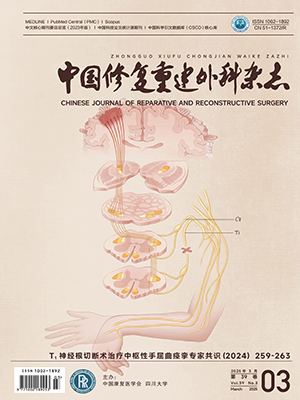| 1. |
Urist MR. Bone: formation by autoinduction. Science, 1965, 150(3698): 893-899.
|
| 2. |
Martínez A, Arana P, Fernandez A, et al. Synthesis and characterisation of alginate/chitosan nanoparticles as tamoxifen controlled delivery systems. J Microencapsul, 2013, 30(4): 398-408.
|
| 3. |
杨强, 彭江, 卢世璧, 等.软骨细胞外基质与壳聚糖复合制备组织工程软骨支架及其性能研究.中华骨科杂志, 2011, 31(8): 904-910.
|
| 4. |
Jingushi S, Urabe K, Okazaki K, et al. Intramuscular bone induction by human recombinant bone morphogenetic protein-2 with beta-tricalcium phosphat e as a carrier: in vivo bone banking for muscle-pedicle autograft. J Orthop Sci, 2002, 7(4): 490-494.
|
| 5. |
Jun SH, Lee EJ, Jang TS, et al. Bone morphogenic protein-2 (BMP-2) loaded hybrid coating on porous hydroxyapatite scaffolds for bone tissue engineering. J Mater Sci Mater Med, 2013, 24(3): 773-782.
|
| 6. |
Wink JD, Gerety PA, Sherif RD, et al. Sustained delivery of rhBMP-2 by means of poly (lactic-co-glycolic acid) microspheres: cranial bone regeneration without heterotopic ossification or craniosynostosis. Plastic Reconstr Surg, 2014, 134(1): 51-59.
|
| 7. |
王玮, 尹庆水, 张余.重组人骨形态发生蛋白-2壳聚糖纳米微球的制备及检测.中国骨与关节损伤杂志, 2011, 26(7): 598-600.
|
| 8. |
夏远军, 章莹, 李丽华, 等.壳聚糖/硫酸葡聚糖/重组人骨形态发生蛋白-2微球对SD大鼠骨髓基质干细胞增殖与分化的影响.中华创伤骨科杂志, 2014, 16(5): 421-426.
|
| 9. |
Lai RF, Li ZJ, Zhou ZY, et al. Effect of rhBMP-2 sustained-release nanocapsules on the ectopic osteogenesis process in Sprague-Dawley rats. Asian Pac J Trop Med, 2013, 6(11): 884-888.
|
| 10. |
Mankani MH, Kuznetsov SA, Fowler B, et al. In vivo bone formation by human bone marrow stromal cells: effect of carrier particle sizeand shape. Biotechnol Bioeng, 2001, 72(1): 96-107.
|
| 11. |
Hou J, Wang J, Cao L, et al. Segmental bone regeneration using rhBMP-2-loaded collagen/chitosan microspheres composite scaffold in a rabbit model. Biomed Mater, 2012, 7(3): 035002.
|
| 12. |
Bae IH, Jeong BC, Kook MS, et al. Evaluation of a thiolated chitosan scaffold for local delivery of BMP-2 for osteogenic differentiation and ectopic bone formation. Biomed Res Int, 2013, 2013: 878930.
|
| 13. |
Ho TS, Hutmacher DW. Application of micro CT and computation modeling in bone tissue engineering. Computer-Aided Design, 2005, 37(11): 1151-1161.
|
| 14. |
Ho ST, Hutmacher DW. A comparison of micro CT with other techniques used in the characterization of scaffolds. Biomaterials, 2006, 27(8): 1362-1376.
|
| 15. |
Lauten EH, Ver Berkmoes J, Choi J, et al. Nanoglycan complex-formulation extends VEGF retention time in the lung. Biomacromolecules, 2010, 11(7): 1863-1872.
|
| 16. |
des Rieux A, Ucakar B, Mupendwa BP, et al. 3D systems delivering VEGF to promote angiogenesis for tissue engineering. J Control Release, 2011, 150(3): 272-278.
|
| 17. |
Lindhorst D, Tavassol F, von See C, et al. Effects of VEGF loading on scaffold-confined vascularization. J Biomed Mate Res A, 2010, 95(3): 783-792.
|
| 18. |
夏远军, 章莹, 李丽华, 等. rhBMP-2/壳聚糖/硫酸葡聚糖复合微球制备及其生物安全性研究.中国骨科临床与基础研究杂志, 2013, 5(6): 345-349.
|




